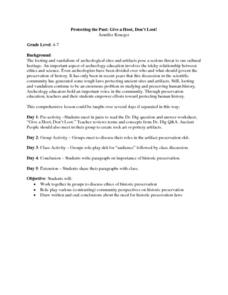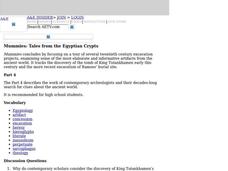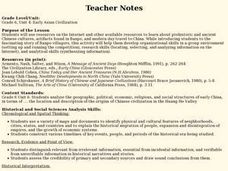Curated OER
Garbage Can Archaeology
Young scholars explore the use of stratigraphy to date objects by sorting the material in the wastebasket. They make a list of actual items from the garbage can and their possible uses and categorize the artifacts.
T
Curated OER
Teaching About Trade in the Ancient Mediterranean
Sixth graders examine the trade routes in the Mediterranean of the Ancient world. In groups, they view slides of artifacts while answering questions on a worksheet. After watching a video, they discuss how each object was found and...
Curated OER
Ancient Cyprus: The Cesnola Collection at the Semitic Museum, Harvard University
Ninth graders review what they already know about ancient civilizations. Before visiting the museum, they complete a pre-test on Cyprus and how trade is important to the island. During the visit, they travel in small groups to examine...
Curated OER
My Brother Sam is Dead: A study of the Revolutionary War
Fifth graders complete an analysis of the Revolutionary War through literature. After "My Brother Sam Is Dead," students create a time capsule containing items that would be relevant during the Revolutionary War. They identify key...
Curated OER
Our Town
Students discover what makes a community run smoothly by reading signs and visiting various places in their community. In this social studies lesson, small groups of students take photographs of community signs and places and then ask...
Curated OER
Making a Mola
Sixth graders explore the term mola. For this social studies lesson, 6th graders create a visual representation of a mola. Additionally, students design their own mola to include important parts of their lifestyle.
Curated OER
Bringing the Past to the Present
Second graders work in pairs and read a primary source artifact. They create a PowerPoint slide that will be part of a "museum" presentation for the rest of their class. Students select artifacts from a group of digitalized artifacts...
Curated OER
Pottery Analysis
Students study how archaeologists analyze artifacts to answer questions about past cultures. They explain why pottery is important to archaeologists and how they use classification to answer their research questions.
Curated OER
Point of View
Students participate in an inkblot test to discuss how what they see is different than their classmates. After viewing various artifacts, they write down what they believe the object is and then they are placed into a group to discuss...
Curated OER
Archeological Thinking
Sixth graders review the differences between a historian and archaeolgists. At a recent archaeological dig site, they examine the artifacts and determine their usage. In groups, they are given a bag full of artifacts and write down what...
Curated OER
Entertaining Vancouver's Youth During World War II.
Learners investigate relevant period documents and artifacts and have the
opportunity to replicate a 1943-44 entertainment experience by viewing a program
of World War II era motion pictures on site at Vancouver's historic...
Curated OER
My How Things Have Changed
Eighth graders discuss the impact geography had on hunter-gatherer societies, their toolmaking. They work in groups to create a Web page that links pictures of artifacts to explanations about what the artifact tell us about the lives of...
Curated OER
New England Colonials: John Stebbins and Ebenezer Wells (1691-1758)
Tenth graders learniabout life in Deerfield during growth period through the examination of artifacts and documents of Stebbins and Wells.
Curated OER
Does This Belong to You?
Fourth graders examine legislation that has been passed to protect the rights and religion of Native Americans. In groups, they discuss their feelings on others taking artifacts from Native American sites and what they do if they find...
Curated OER
Clues to the Past
Students analyze how arhaeologists study the past. They define basic archaeological terms, make general inferences from observations, and explain the importance of context.
Curated OER
Protecting the Past: Give a Hoot, Don't Loot
Students discuss the looting and vandalism of various archeological sites. In pairs, they read and complete a worksheet and review their answers as a class. In groups, they role play a artifact preservation skit and perform it to their...
Curated OER
The Empires of Early Africa
Students view the video "Empires of Early Africa." They are asked: Who was Nefertiti? They review the facts about Akhenaten and Nefertiti. Students discuss how archaeologists looked for clues to determine the identity of the mummy...
Curated OER
Show and Share
Students share personal stories and artifacts, creating a community of trust and sharing.
Curated OER
Why Archaeologists Dig Square Holes
Students examine how archaeologists establish and maintain the context of artifacts. They interpret a plan view of an archaeological site and explain the importance of the grid system.
Curated OER
Past v. Present: Using Geography & Anthropology
Students examine artifacts and documents from their Canadian community. They analyze early Canadian history and make predictions about the future of the country.
Curated OER
Mummies: Tales from the Egyptian Crypts Part IV
Students choose one or two of the artifacts found in King Tutankhamen's tomb and describe and analyze the artifact. Explain what it tells us about Tutankhamen's life and about ancient Egyptian culture.
Curated OER
Banpo Village: Gone, But Not Forgotten
Sixth graders plan a trip to China and prepare yourself for the Banpo excavation site competition by studying prehistoric and ancient Chinese history.
Curated OER
War and Remembrance
Students explore the controversy surrounding the ban of Nazi memorabilia and other hate-related artifacts from online auction sites.
Curated OER
Interviewing A Parent
Young scholars conduct an interview with a family member to research their family history. They prepare a list of questions, conduct the interview, and determine which house to visit for an artifact search.

























